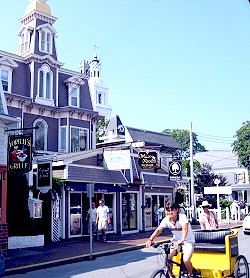
Cape Cod, hmmm. We racked our brains and came up with romping Kennedys and a cocktail that involves vodka and cranberries.
We didn’t have any idea what we might discover if we drove all the way out to the end of Cape Cod but we had to do it — it was just too enticing to resist, challenging us there on the map.
The pine trees dwindled and the sand dunes gained hold as we approached the very tip of the cape and found lovely, eclectic Provincetown. P-town to the locals.
Home to amazing restaurants, America’s oldest gay bar and a massive monument recognizing the place where the Pilgrims really first landed, P-town possesses copious quantities of character. Toss in the power and beauty of the Atlantic Ocean encircling the tiny strip of land — forming dazzling beaches — and it becomes nearly impossible not to love this easternmost tip of Massachusetts.
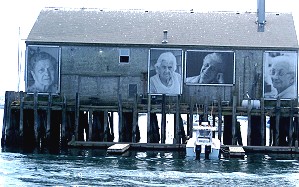
For centuries the bitter end of Cape Cod was home to only whalers
and fishermen. The population grew through the 1800s as numerous
Portuguese sailors settled in P-town and their influence is still strong
today.
Every year P-town hosts a Portuguese festival in late June and “They Also Faced the Sea,” a series of large portraits of Portuguese-American women living in Provincetown, is a beautiful tribute to the hardworking women who have kept tradition alive for over two centuries.
Through the years many writers, actors and artists sought the solace, solitude and inspiration that Cape Cod offered and settled among the seafarers. The eclectic mix worked well, with everyone adopting a live and let live attitude. Today Provincetown is very much a summer destination, with the population increasing nearly tenfold during the season. Only a little over 3,000 hardy souls are willing to brave the North Atlantic winters.

We started the day by making our way up to the Pilgrim Monument and Provincetown Museum. The monument is a huge tower modeled after the Torre del Mangia in Siena, Italy.
With President Teddy Roosevelt laying the cornerstone in 1907, the tower was built to commemorate the signing of the Mayflower Compact and mark the place where the Pilgrims actually first landed in November of 1620.
Immediately upon arrival, our celebrated Pilgrims began raiding the local Nauset tribe’s graves and food stores. None too pleased with these newcomers stealing their corn right before winter, the Nauset forced the would-be settlers across the bay to Plymouth and its famous, if not entirely factual, rock.

Staring up at the 252 foot structure, we girded our loins for the 176 step climb to the crown (sorry, no elevators!). Trudging ever upward, we dug in as we tried to disregard our aching calves and ignore the adolescent boys whizzing by. Showoffs.
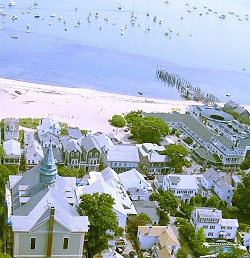 At the top, we were rewarded with breathtaking panoramic views of Provincetown and Cape Cod Bay and hey, we got a sticker bragging that we made it to the top.
At the top, we were rewarded with breathtaking panoramic views of Provincetown and Cape Cod Bay and hey, we got a sticker bragging that we made it to the top.
Love us some goofy stickers!
Since parking is at quite a premium in P-town and the monument is near the center of town, we decided to take advantage of their lot and continued our exploration on two wheels.
Provincetown is incredibly bicycle friendly, it seemed like more bikes than cars were on the road. We brought our bikes with us, but rentals are readily available. Good thing too, because driving a car is nearly impossible through the narrow streets that are completely packed with pedestrians and cyclists in the summer months.
Though we have to say, the bicyclists are just as aggressive as the motorists in Massachusetts, so we were kept on our toes.
We stopped for lunch at Enzo, in the heart of the Commercial Street district to sit outdoors and enjoy some bang-up people watching.
Enzo, a restaurant and guesthouse in an old Victorian mansion, has a spectacular raw bar lunch. Imagine little neck clams for $1.50 each, Wellfleet oysters for two bucks or a lobster tail for eight. And the decadent spicy seafood chowder. Uh, wicked delicious.
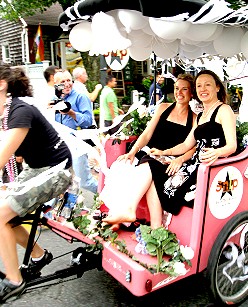 Sitting outside and watching the world go by at one of the many hotspots on Commercial Street should be mandatory doings
Sitting outside and watching the world go by at one of the many hotspots on Commercial Street should be mandatory doings
in P-town.
It makes one’s heart sing to see so many happy couples strolling by, hand-in-hand, without a care in the world.
We were lucky enough to see a wedding procession heading down Commerce Street (everyone on bikes, no less) and were swept up in the laughter of the revelers.
We were given an enthusiastic “thumbs up” and a big happy grin as we snapped a shot of the beaming couple. A quick note to first time visitors: It gets pretty raucous on Commerce Street as night falls, not a place for the kiddies or the easily shocked, so here’s a good rule of thumb — if the French Quarter of New Orleans offends you, so will Commerce Street at night. A big time is had by all.
As we continued exploring the waterfront, we stumbled upon Captain Jack’s Wharf. A colorful collection of wooden domiciles, available to rent by the week, stacked upon an antiquey-looking pier jutting haphazard into the harbor.
Captain Jack’s looked like our kind of place. Several of the current inhabitants, boasting quite an array of European accents, were sunning, swimming and swilling a few drinks on the tiny strip of sand between their dock and the next group of houses.
Not much of a beach, but its coolness factor
more than made up for it.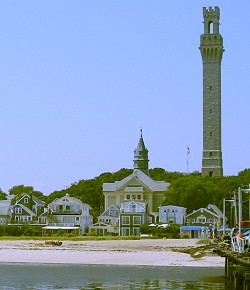
After pedaling a few miles up and down the main drag, The Atlantic House seemed like it would make a good stop and give us an excuse for a little libation. Known locally as The A-House, it has quite a history. Opened in 1798 as a tavern, this is P-town’s oldest bar.
The Atlantic has also served as a stage coach stop, hotel and restaurant. Many artifacts from its storied past adorn the walls.
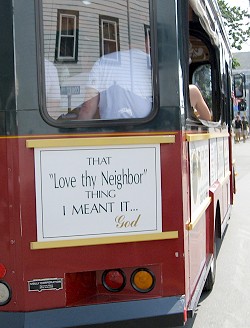
During the 1920s the A-House became a popular hangout for some of America’s most famous writers. Eugene O’Neill and Tennessee Williams were frequent patrons.
Appealing to artistic and alternative lifestyles through the years, The Atlantic House became known as America’s first gay-friendly bar back in the early 1950s.
This live-and-let-live philosophy has served not just the bar but the whole town well.
As a sign on a trolley headed down Commerce Street said, “That ‘Love thy Neighbor’ thing? I MEANT IT…God.”
P-town means it as well.
David & Veronica, GypsyNester.com



You certainly stoked my wanderlust with this! I’ve wanted to visit Cape Cod ever since I read Thoreau book of the same name year ago! It sounds like somewhere I might never want to leave is the only problem!
Or at least until the first Nor’ Easter hits! 😉
>I spent my summers I P-town as a kid camping out on the National Seashore at Race Point (the VERY tip of Cape Cod. My Dad built a makeshift camper out of an old bread delivery truck, complete with bunks, a gas stove and a pump sink. You don't want to know about the bathroom facilities! We never had much money when I was a kid, but my ocean front beach bum camping experiences filled me with more fabulous childhood memories than any fancy vacation ever could. I watched the first lunar landing on a tiny b/w tv hooked up to the truck's battery. Way too many memories to share here, but P-town willalways hold a special place in my heart.
>You didn't ask anyone about the blue line painted on the base of many houses?
You can’t just ask the question and leave us hanging like that! What are those blue lines all about? Play fair!